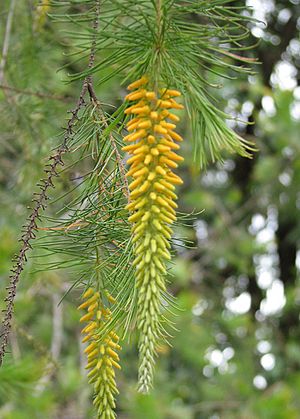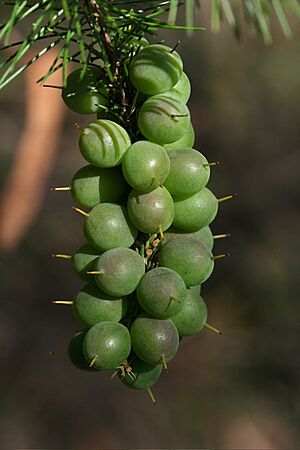Pine-leaved geebung facts for kids
Quick facts for kids Pine-leaved geebung |
|
|---|---|
 |
|
| Persoonia pinifolia in Maranoa Gardens | |
| Scientific classification | |
| Genus: |
Persoonia
|
| Species: |
pinifolia
|
| Synonyms | |
|
Linkia pinifolia (R.Br.) Kuntze |
|
The Persoonia pinifolia, also known as the pine-leaved geebung, is a special plant. In the Cadigal language, it is called mambara. This plant is part of the Proteaceae family. It grows only in the Sydney area of New South Wales, Australia.
It is a tall, woody bush with soft leaves. These leaves look a lot like pine needles. The plant also has long clusters of small yellow flowers. You can see these flowers from late winter through summer.
Contents
What Does the Pine-Leaved Geebung Look Like?
The pine-leaved geebung grows as a tall, woody bush. It can reach up to 3 metres (about 10 feet) high and wide. Its young branches have some soft hairs.
Leaves and Flowers
The leaves are soft and thin, like threads. They are about 30 to 70 millimetres (1 to 3 inches) long. Each leaf is very narrow, only about 0.5 millimetres (0.02 inches) wide. When they are young, the leaves are a bit hairy. As they get older, they become smooth. The tips of the leaves often curve a little.
The yellow flowers grow in long clusters at the ends of the branches. This makes them easy to spot. Each flower has a short, hairy stalk. A small leaf sits at the base of each flower. The flower has four parts called tepals. These are joined at the bottom, but their tips curl back. In the middle of the flower, there are four yellow parts called anthers. They also join at the base and curl back. This makes the flower look like a cross when you see it from the end.
When Does it Flower and What About the Fruit?
This plant mainly flowers from late winter to summer. Sometimes, it can flower in other months too. After the flowers, the plant grows fruit. These fruits are green and fleshy. They look like a bunch of grapes hanging from the plant.
How Did the Pine-Leaved Geebung Get Its Name?
The Persoonia pinifolia was first officially described in 1810. A botanist named Robert Brown wrote about it. He found samples of the plant near Port Jackson, which is in Sydney.
The second part of its scientific name, pinifolia, comes from two Latin words. Pinus means "pine," and folium means "leaf." So, pinifolia means "pine-leaved," which perfectly describes its needle-like leaves.
How Does the Pine-Leaved Geebung Live in Nature?
The fruits of the pine-leaved geebung are eaten by different birds. These birds include the pied currawong, satin bowerbird, regent bowerbird, olive-backed oriole, and Lewin's honeyeater. We don't fully know how this helps the plant spread its seeds.
Most plants in the Proteaceae family have special roots called proteoid roots. These roots help them get nutrients from poor soil. However, the pine-leaved geebung is different. It does not have these special roots.
Can You Grow Pine-Leaved Geebung in a Garden?
The pine-leaved geebung is one of the more popular geebungs grown in eastern Australia. However, it is still not very common in gardens. This is because it can be tricky to grow new plants from seeds or cuttings.
Why is it Hard to Grow from Seed?
It is very hard to make the seeds sprout. This is because the seeds have things that stop them from growing. They also have a thick, hard outer shell. In nature, fire seems to help the seeds grow. It might crack the hard shell or help water get inside. Scientists have tried using artificial smoke, but it hasn't helped much.
Why is it Hard to Grow from Cuttings?
Growing new plants from cuttings is also difficult. People have tried many different ways to help the cuttings grow roots. They have used special plant hormones, honey, sugar, and even coconut milk. But usually, less than 1% of the cuttings grow roots. This makes it hard for plant nurseries to sell them.
However, a nursery owner in New South Wales has been doing research. From 2012 to 2017, he found ways to get about 85% of his cuttings to grow roots. He found that the time of year, the length of the cutting, temperature, and special hormones are all important. Scientists have also had success growing P. pinifolia using tissue culture. This is a method where tiny pieces of the plant are grown in a lab.
See also
 In Spanish: Geebung hojas de pino para niños
In Spanish: Geebung hojas de pino para niños


